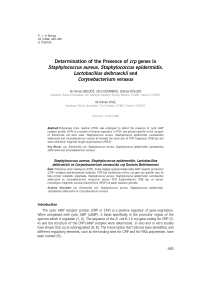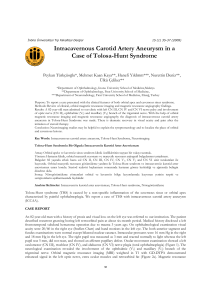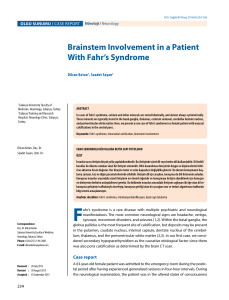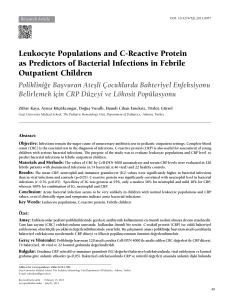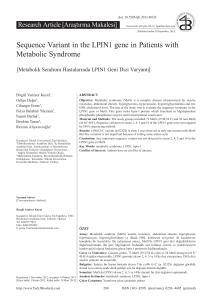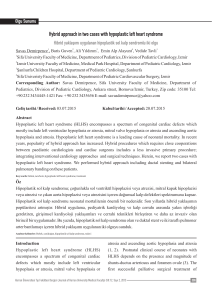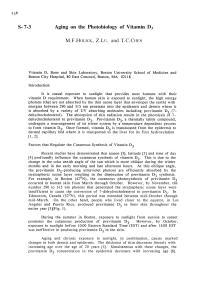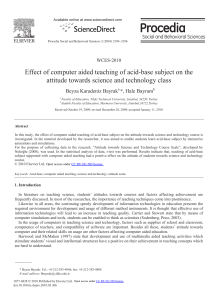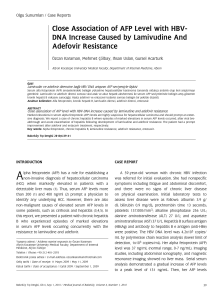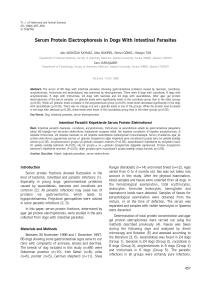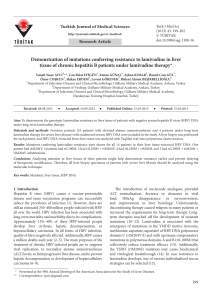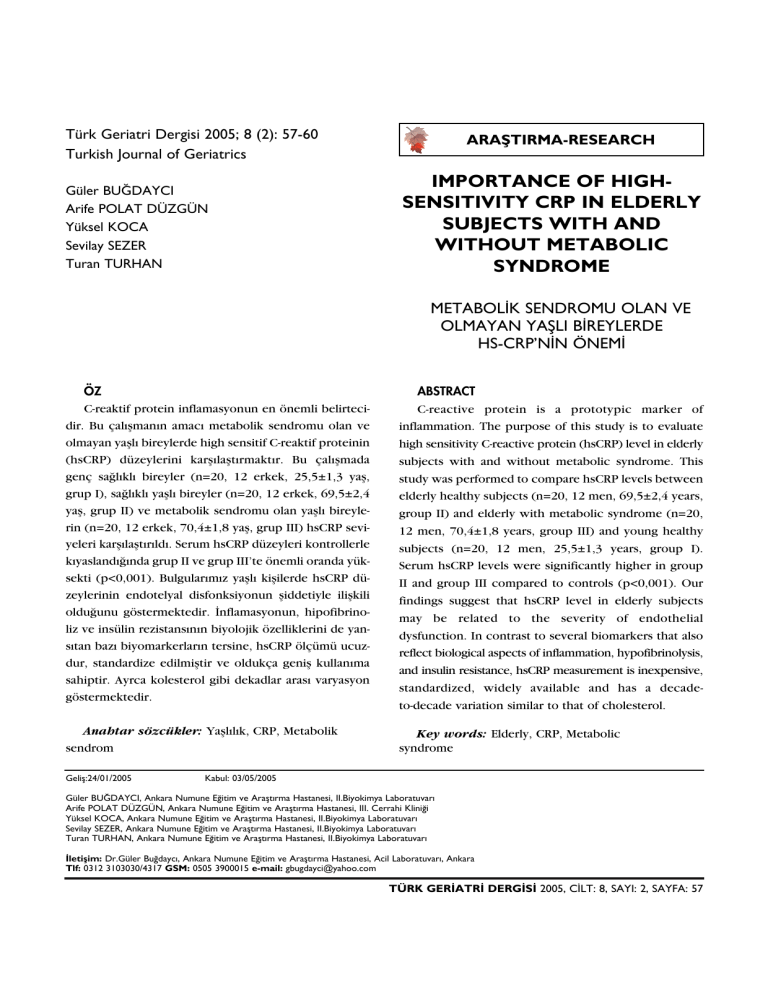
Türk Geriatri Dergisi 2005; 8 (2): 57-60
Turkish Journal of Geriatrics
Güler BU⁄DAYCI
Arife POLAT DÜZGÜN
Yüksel KOCA
Sevilay SEZER
Turan TURHAN
ARAfiTIRMA-RESEARCH
IMPORTANCE OF HIGHSENSITIVITY CRP IN ELDERLY
SUBJECTS WITH AND
WITHOUT METABOLIC
SYNDROME
METABOL‹K SENDROMU OLAN VE
OLMAYAN YAfiLI B‹REYLERDE
HS-CRP’N‹N ÖNEM‹
ÖZ
C-reaktif protein inflamasyonun en önemli belirtecidir. Bu çal›flman›n amac› metabolik sendromu olan ve
olmayan yafll› bireylerde high sensitif C-reaktif proteinin
(hsCRP) düzeylerini karfl›laflt›rmakt›r. Bu çal›flmada
genç sa¤l›kl› bireyler (n=20, 12 erkek, 25,5±1,3 yafl,
grup I), sa¤l›kl› yafll› bireyler (n=20, 12 erkek, 69,5±2,4
yafl, grup II) ve metabolik sendromu olan yafll› bireylerin (n=20, 12 erkek, 70,4±1,8 yafl, grup III) hsCRP seviyeleri karfl›laflt›r›ld›. Serum hsCRP düzeyleri kontrollerle
k›yasland›¤›nda grup II ve grup III’te önemli oranda yüksekti (p<0,001). Bulgular›m›z yafll› kiflilerde hsCRP düzeylerinin endotelyal disfonksiyonun fliddetiyle iliflkili
oldu¤unu göstermektedir. ‹nflamasyonun, hipofibrinoliz ve insülin rezistans›n›n biyolojik özelliklerini de yans›tan baz› biyomarkerlar›n tersine, hsCRP ölçümü ucuzdur, standardize edilmifltir ve oldukça genifl kullan›ma
sahiptir. Ayrca kolesterol gibi dekadlar aras› varyasyon
göstermektedir.
ABSTRACT
C-reactive protein is a prototypic marker of
inflammation. The purpose of this study is to evaluate
high sensitivity C-reactive protein (hsCRP) level in elderly
subjects with and without metabolic syndrome. This
study was performed to compare hsCRP levels between
elderly healthy subjects (n=20, 12 men, 69,5±2,4 years,
group II) and elderly with metabolic syndrome (n=20,
12 men, 70,4±1,8 years, group III) and young healthy
subjects (n=20, 12 men, 25,5±1,3 years, group I).
Serum hsCRP levels were significantly higher in group
II and group III compared to controls (p<0,001). Our
findings suggest that hsCRP level in elderly subjects
may be related to the severity of endothelial
dysfunction. In contrast to several biomarkers that also
reflect biological aspects of inflammation, hypofibrinolysis,
and insulin resistance, hsCRP measurement is inexpensive,
standardized, widely available and has a decadeto-decade variation similar to that of cholesterol.
Anahtar sözcükler: Yafll›l›k, CRP, Metabolik
sendrom
Key words: Elderly, CRP, Metabolic
syndrome
Gelifl:24/01/2005
Kabul: 03/05/2005
Güler BU⁄DAYCI, Ankara Numune E¤itim ve Araflt›rma Hastanesi, II.Biyokimya Laboratuvar›
Arife POLAT DÜZGÜN, Ankara Numune E¤itim ve Araflt›rma Hastanesi, III. Cerrahi Klini¤i
Yüksel KOCA, Ankara Numune E¤itim ve Araflt›rma Hastanesi, II.Biyokimya Laboratuvar›
Sevilay SEZER, Ankara Numune E¤itim ve Araflt›rma Hastanesi, II.Biyokimya Laboratuvar›
Turan TURHAN, Ankara Numune E¤itim ve Araflt›rma Hastanesi, II.Biyokimya Laboratuvar›
‹letiflim: Dr.Güler Bu¤dayc›, Ankara Numune E¤itim ve Araflt›rma Hastanesi, Acil Laboratuvar›, Ankara
Tlf: 0312 3103030/4317 GSM: 0505 3900015 e-mail: [email protected]
TÜRK GER‹ATR‹ DERG‹S‹ 2005, C‹LT: 8, SAYI: 2, SAYFA: 57
IMPORTANCE OF HIGH-SENSITIVITY CRP IN ELDERLY SUBJECTS WITH AND WITHOUT
METABOLIC SYNDROME
INTRODUCTION
High-sensitivity C-reactive protein (hsCRP) represents a
powerful cardiovascular risk predictor (1,2). C-reaktif protein
(CRP), a marker of inflammation, identifies a different highrisk group than the traditional parameters of the metabolic
syndrome and provides additional information on the cardiovascular risk (3). Inflammation of arteries may be an important component of changes in plaque morphology, rupture,
and trombosis. In this setting, inflammation may or may not
include immune activation but would certainly include the
elaboration of proinflammatory cytokines. CRP taken up by
monocytes may also increase production of tissue factor and
the propensity for subsequent trombosis (4,5).
In 2001, The National Cholesterol Education Program
Adult Treatment Program (NCEP ATP III ) guidelines defined
metabolic syndrome (6). The ATP III guideline also suggest a
working definition of the metabolic syndrome that includes
the presence of at least 3 of the following charecteristics; abdominal obesity, elevated trigliserides, reduced levels of HDL
cholesterol, high blood pressure, and high fasting glucose.
However, all of these parameters are associated with elevated
levels of hsCRP (5).
hsCRP levels of less than 1, 1 to 3, and greater than 3
mg/dl are associated with lower, moderate, and higher cardiovascular risk, prospectively (7,8). Inflammation is a major
factor in atherotrombotic disease. Levels of hsCRP a marker of
systemic inflammation and a mediator of atherothorombotic
disease, have been shown to correlate with metabolic syndrome (9).
The present study was designed to evaluate hsCRP levels
elderly subjects with and without metabolic syndrome.
METHODS
Participants and Protocol
The local ethics committee approved the study protocol;
all participants gave written informed consent. Twenty young
and twenty elderly healthy normotensive subjects and in addition 20 elderly subjects with metabolic syndrome were included in this study. Metabolic syndrome was defined according
to ATP III Guideliness. The samples were obtained from antecubital vein using a 19 gauge sterile needle and blood was allowed to flow freely in to vacutainer tubes (no additives). Participants with 3 or more of following attributes are typically
defined as having the metabolic syndrome: (1) triglyserides >
150 mg/dl; (2) HDL-cholesterol < 50 mg/dl; (3) blood pressure > 135/85 mmHg; (4) obesity as defined by a waist circumference > 88 cm for women, > 105 cm for men; and (5) abnormal glucose metabolism as defined by a fasting glucose >
110 mg/dl (10,11). All participants were nonsmoking. Blood
samples for measurements were taken without venous compression after at least 100 minutes of supine position.
Measurement and Calculations
Glucose, triglicerides, HDL-cholesterol, albumin levels
were measured with original kits using Abbott-Aeroset autoanalyzer (Chicago,IL,USA). Fibrinogen levels were measured
with Sigma kits using AMAX-200 (Sigma Co,St Louis,USA).
CRP levels were determined by immunoturbidimetric methods in the Aeroset (Abbott-USA) Autoanalyser. Ultra CRP
(hsCRP) reagents were purchased from Sentinel Diagnostic
(Sentinel-Italy-Catalog No: 11 508). The results are prensented as mg/dl (measuring range 0,005-16 mg/dl). We were measured hsCRP with Abbott-Aeroset autoanalyzer (Chicago,IL,USA).
Statistical analysis
The SPSS package was used for statistical analysis. Comparison groups was done by using ANOVA after normality of data distribution was confirmed with the Kolmogorov-Smirnov
Test. The zero hypothesis was rejected at a probability level
of 0,001. All results were expressed as mean ± standart deviation (SD).
RESULTS
The clinical and biochemical caharecterisitics of elderly
subjects and their age-matched controls were summarized in
Table 1. Serum hsCRP levels were higher in group II and group III compared to controls (p<0,001). Serum hsCRP levels
were shown in Figure I.
Serum albumin levels were not differed among groups
(p>0,05). Serum fibrinogen levels of group III were higher
than group I and group II levels ( p<0,001). Serum hsCRP levels were shown in Figure I.
DISCUSSION
The results of the present study shown markedly increased serum hsCRP in all elderly subjects. These prospective
data suggest that measurement of CRP adds clinically important prognostic information to the elderly subjects with or
without metabolic sendrom. Our aim was to assess in its role
the pathophysology of age-related endotheial dysfunction.
Figure 1- hsCRP levels in young subjects(I) and elderly subjects with(III)
or without(II) Metabolic Syndrome
TURKISH JOURNAL OF GERIATRICS 2005, VOLUME: 8, NUMBER: 2, PAGE: 58
METABOL‹K SENDROMU OLAN VE OLMAYAN YAfiLI B‹REYLERDE HS-CRP’N‹N ÖNEM‹
Tacy et al. found that CRP was associated with incident
events in the elderly, especially with subclinical disease at baseline. They performed a similar study in the Rural Health Promotion Project, in which mean values of CRP were higher for
female case subjects than for female control subjects, but no
differences were apperent for men (2). In our study, the mean CRP level was higher either health elderly subjects or elderly with metabolic sendrom (p<0,001). In previous reports,
lower levels of albumin and higher levels of fibrinogen (both
inflammation-sensitive protein, like CRP) have also been associated with increased risk of endothelial dysfunction (12). In
our study, serum albumin levels were not differed among groups (p>0,05). Serum fibrinogen levels of group III were higher than group I and group II levels ( p<0,001).
Frederikson et al. investigated association between diet, lifestyle, metabolic cardiovascular risk factors and plasma CRP
levels. Their observation suggest that CRP levels are only marginally associated with individual dietary and lifestyle factors
(low vitamin C intake, smoke, high fiber vitamin C intake, β
carotene intake). Also they found increased with high body
mass index (p=0,019), HDL-cholesterol (p=0,009) and low
HDL cholesterol (p=0,01) (13).
Penninx et al. found elevated interleukin 6 (IL-6), tumor
necrosing factor- alpha (TNF-α), hsCRP level in depressed mood in older persons. In old age, depressed mood is associated
with high levels of inflammatory markers, suggesting that depressed mood is causing and/or caused by systemic inflammation (14).
Ridker et al. found that median CRP levels for those with
0,1,2,3,4 or 5 characteristics of metabolic syndrome were
0.68, 1.09, 1.93, 3.01, 3.88 and 5.75 mg/L, respectively. Over
the 8-year follow-up, cardiovascular event-free survival rates
based on CRP levels above or below 3.0 mg/L were similar to
survival rates based on having 3 are more charecteristic of the
metabolic syndrome (15).
Schillinger et al. found hsCRP and glycated hemoglobin in
patients with advanced atherosclerosis. Inflammation indicated by hsCRP and hyperglycemia, indicated by HbA1c, jointly
contribute to the cardiovascular risk of patients with advanced atherosclerosis. Patients with both hsCRP and HbA1c in
the upper quartiles (> 0.44 mg/dl and > 6.2%, respectively)
are at particularly high risk for poor cardivascular outcome
(16).
This study was performed to compare concentrations of
hsCRP between elderly subjects with (n=20, 12 men,
70,4±1,8 years) and without metabolic syndrome (n=20, 12
men, 69,5±2,4years ) and young healthy subjects (n=20, 12
men, 25,5±1,3 years). Serum hs-CRP concentration were significantly higher (p<0,001) in elderly than in young healthy
subjects. Our findings suggest that hsCRP level in elderly subjects may be related to the severity of endothelial dysfunction.
Given the consistency of prognostic data for hsCRP and the
practicality of its use in outpatient clinical criterion for metabolic syndrome. Further prospective studies are warrented to
determine the diagnostic value of hsCRP level.
REFERENCES:
1. Linton MF, Fazio S: A practical approach to risk assesment to prevent coronary artey disease and its complication. AM J Cardiol
2003;92;19i-26i.
2. Tracy RP, Lemaitre RN, Psaty BM, et al.: Relationship of C-reactive protein to risk of cardiovascular disease in the elderly: results
from the Cardiovascular Health Study andthe Rural Health Promotion Project. Arteriscler Thromb Vasc Biol. 1997; 17:1121-27.
3. Scott CL.Diagnosis,prevention, and intervention for the metabolic syndrome:Am J Cardiol 2003; 92: 35i-42i
Table 1- Baseline characteristics of the groups
Group I
Age (years)
Sex(M/F)
Diabetes (%)
Hypertension (%)
SBP, mmHg
(SD) DBP, mmHg
Cholesterol, mg/dl
Total
Triglycerides, mg/dl
HDL, mg/dl
hsCRP, mg/dl
Albumin, mg/dl
Fibrinogen, mg/dl
25,5
Group II
69,5
Group III
(1,3)
12/8
0
0
107,7 (8,2)
70,5 (4,2)
149,3 (20,3)
(2,4)
12/8
20
75
132,3 (11,0)
70,4
144,7
(1,8)
12/8
65
80
(13,4)
202,0 (21,1)
234,8
(24,5)
71,1 (14,3)
52,6 (6,5)
1,48 (0,5)
43,8 (3,8)
176,6 (17,7)
95,9 (34,8)
46,4 (6,3)
2,9 (0,4)
43,0 (2,2)
223,6 (56,9)
193,3
39,1
4,6
38,5
283,5
(65,7)
(8,6)
(1,0)
(11,9)
(0,5)
Group I: young healthy subjects; Group II elderly healthy subjects; Group III elderly with metabolic syndrome
SBP, indicates systolic blood pressure; DBP, diastolic blood pressure
All values shown as mean (SD).
TÜRK GER‹ATR‹ DERG‹S‹ 2005, C‹LT: 8, SAYI: 2, SAYFA: 59
IMPORTANCE OF HIGH-SENSITIVITY CRP IN ELDERLY SUBJECTS WITH AND WITHOUT
METABOLIC SYNDROME
4. Frohlic M, Imhof A, Berg C,et al: Association between C-reactive
protein and features of the metabolic syndrome: a population based study. Diabetes Care.2000;23:1835-1839.
5. Shidama K, Miyazaki T, Daida H. Adiponectin and atherosclerotic
disease. Clin Chim Acta.2004;344:1-12.
6. Expert Panel on Detection,Evaluation, and Treatment of High
Blood Cholesterol in Adults. Executive summary of the Third
Report of the National Cholesterol EducatioProgram (NCEP) Expert Panel on Detection, Evaluation and Treatment of High Blood Cholsterol in Adults (Adult Treatment Panel III ). JAMA.
2001;19:2486-2497.
7. Bassuk SS, Rifai N, Ridker PM.: High-sensitivity C-reactive protein;
clinical importance.Curr Probl Cardiol 2004, Aug; 29(8):439-93.
8. Ridker PM: High-sensitivity C –reactive protein and cardiovascular risk: rationale for screening and primary prevention. Am J Cardiol.2003 21; 92(4B): 17K-22K.
9. Ridker PM, Hennekens CH, Buring JE : C-reactive protein and other markers of inflammation in the prediction of cardiovascular
disease in women . N Eng J Med. 1997; 336:973-79.
10. Lindblad U, Langer RD,Wingard DL,Thomas RG, Barrett-Connor
E: Metabolic Sydrome and ischemic heart disease in elderly men
and women. Am J Epidemiol 2001; 153:481-89.
11. Isomaa B, Almgrem P, Tuomi T: Cardiovascular morbitiy and mortality associated with the metabolic syndrome. Diabetes Care
2001;24:683-89.
12. Ridker PM, Wilson PW, Grandy SM: Should C-reactive protein be
added to metabolic syndrome and to assessment of global cardiovascular risk? Circulation 2004; 109 (23):2818-25.
13. Frederikson GN, Hedblad B, Nilsson JA, Alm R: Association between diet, lifestyle,metabolic cardiovacular risk factors and plasma CRP levels. Metabolism 2004; 53 (11); 1436-42.
14. Penninx BW, Kritchevsky SB, Yaffe K ,Newman AB, Simonsick
EM,Rubin S et al.: Inflammatory markers and depressed mood in
older persons; results from the health, aging and body composition study. Biol Psychiatry 2003 1; 54 (5): 566-72.
15. Ridker PM, Buring JE, Cook NR, Rifai N : C-reactive protein, The
metabolic syndrome and risk of incident cardiovascular events.
Circulation 2003; 107;391-97.
16. Schillinger M, Exner M, Amighi J, Mlekush W, Sabeti S, Rumpold
H, Wagner O, Minar E: Joint effects of C-reactive protein and
glycated hemoglobin in prediciting future cardiovascular events
of patients with adnvanced atherosclerosis.Circulation 2003;
108:2323-28.
TURKISH JOURNAL OF GERIATRICS 2005, VOLUME: 8, NUMBER: 2, PAGE: 60

